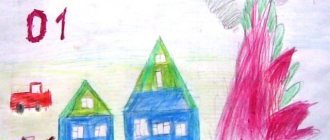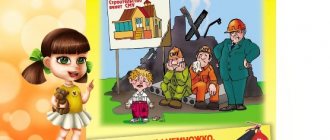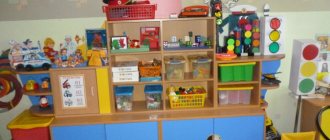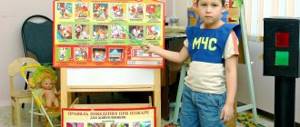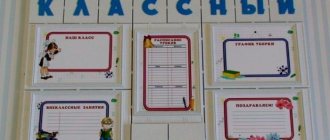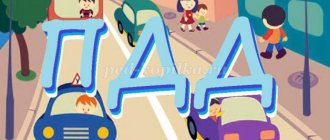Goals of classes on fire safety within the framework of the pedagogical process in preschool educational institutions
Fire safety training is included in life safety classes in preschool institutions. This educational activity has the following objectives.
- Show preschoolers the importance of fire in human life, teach them how to handle it safely.
- Explain the reasons that can provoke a fire: both in everyday life and in nature.
- Teach children the basic rules of behavior in case of fire.
- To give an idea of the socially significant and dangerous profession of firefighter.
- Introduce works of fiction that touch on the topic of fire and firefighters.
- To instill in preschoolers a caring attitude towards their own life, health, the ability to be responsible for their actions, and a desire to help others.
In general, preschoolers must understand three key concepts: the fire itself (its destructive impact on humans and nature), its causes and consequences (loss of life, health, property, damage to nature).
Specific tasks and techniques relevant for different groups
Firefighting educational activities begin from the second junior group. The teacher introduces children of the fourth year of life to the concept of “fire” and talks about its consequences. Children will also learn about sources of danger in the house that can cause a fire. This is an iron that they forgot to turn off, a hot stove (it can cause a towel to catch fire, etc.). At this age, the initial understanding of the profession of a firefighter is also formed.
Classes on fire safety for 3-4 year old children should be carried out exclusively in the form of games, with the use of toys, fairy-tale characters, etc. The teacher must make the material extremely accessible to children’s understanding and use maximum clarity.
In the second junior group, children receive primary knowledge on fire safety
In the middle group, the acquired primary knowledge is expanded. The children become more familiar with the functioning of the fire service and learn how to behave correctly in the event of a fire. Understanding of the causes of the fire is being clarified.
Note that at this age the play component in the lesson is still important.
As for the senior and preparatory groups, here preschoolers’ knowledge of fire safety is deepened and systematized. Future schoolchildren should already have a good understanding of the actions that are necessary in the event of a fire, understand the interrelationship of various fire service units (message to the dispatch service - combat crew - rescuers arriving at the scene), know its telephone number. Future schoolchildren can name works of art on the specified topic, are able to draw a scene of a fire and firefighters, and make a craft.
Provided that fire safety is systematically taught, future schoolchildren have a stock of knowledge and can implement it in productive activities
In the senior and preparatory groups, teaching methods are expanding. The activity can be not only playful, but also informational and educational, for example, a fascinating story from the teacher about how ancient people invented fire. At this age, you can organize excursions to the fire department or invite a real firefighter to visit.
Older preschoolers will be happy to listen to a story about their work as a firefighter
Fire safety on the street
A dangerous fire can occur not only at home, but also outside. For example, you may encounter dry grass burning. During training, children are taught how to properly make fires and the need to remove trash, papers, and flammable objects after themselves. The resulting material is consolidated in playful forms and in creativity. You can invite children to draw a picture based on the theme, color pictures, or create applications. Following the results, an exhibition of works will be organized.
Fire behavior in the forest
Children should know the rules of behavior not only in everyday life, but also in nature. Preschoolers can go out into nature in organized groups with teachers. Such a vacation is not always safe, since forest fires are considered one of the most destructive disasters.
Rules of conduct in transport for school-age children
When letting children go into the forest with a group, you need to give them safety instructions:
- The child should know that fire from a lit fire can very quickly spread to dry grass. It must be extinguished immediately with sand, water or clothing.
- If you cannot cope with the fire, you need to leave the danger zone as quickly as possible and call the fire department.
When running away from fire, you need to take into account the direction of the wind!
Fireworks are not a toy for children
An unchanging attributes of the New Year holidays - colorful fireworks attract children's attention, but pose a huge danger. Parents need to teach their children from early childhood that pyrotechnics should not be approached without adults. It should only be stored out of the reach of children.
Special control is exercised over the sale of pyrotechnic products. It can be purchased only from 14 years of age, some products are allowed for sale only from 18 years of age.
Important! Parents should only use fireworks strictly in accordance with the manufacturer's instructions.
Types of activities
Fire safety classes when working with preschoolers can be conducted in various forms.
Game activities
The most exciting option is to turn educational activities into games, the most natural type of children’s activity. In this case, the child will quietly acquire useful knowledge. Game classes can take place in the form of a travel game; often the teacher attracts fairy-tale characters who need to be helped or taught something.
Children are always enthusiastic about role-playing games. The topic of fire safety is covered by such options as “Family outdoor recreation” (the risk of a forest fire), playing out the situation “Call the fire service by phone 01”. At the same time, the teacher distributes roles, thinks through the plot and selects the necessary attributes. In the process of such an exciting activity, preschoolers remember well who to call when a fire is detected, what to say, what to do when adults are not at home.
By participating in a role-playing game, the child takes an active position, “lives” a certain situation, which, of course, contributes to the acquisition of knowledge and skills.
Role-playing game allows the child to experience a real life situation
Drama games involving toy cars, house models, and human figures are also useful. Preschoolers control their actions by simulating a particular situation, for example, the process of extinguishing a fire.
Manipulating toys helps to learn useful fire safety knowledge
In senior and preparatory groups, fire safety classes can be conducted in the form of quizzes or competitions ( poetry and art, music and sports). This gives schoolchildren the opportunity to express themselves; parents can even be invited to such events. When holding gaming competitions, you need to consider a number of points:
- voluntary participation of children (the teacher’s task is to create motivation for this);
- bright, memorable names of competitions;
- incentives (for example, in the form of symbolic prizes);
- guys who do not directly participate in the competition are involved as a jury;
The structure of the game lesson can also include outdoor games, relay races on a suitable topic (“Firemen’s Assistants”, “Put Out the Fire”) and didactic games. As for the latter, the teacher uses printed material (you can make it yourself). An example of a manual is “The Fourth Odd One”: from the proposed pictures you need to choose an object that cannot cause a fire (boiler, TV, painting, iron). Another suitable option is “Choose the right one”: you need to select items that are attributes of a firefighter (helmet, telephone, lighter, box of sand, oxygen mask, fire hose).
Cognitive activities
In the senior and preparatory groups, educational classes can be conducted. The teacher conveys certain information to the children, for example, on the topic “Electrical appliances in the house that are dangerous,” “The profession of a firefighter,” etc., asking the children reinforcement questions along the way. In this case, clarity must be used - attributes of a firefighter, real electrical appliances, colorful pictures and photographs.
Cognitive activities should include maximum clarity
Communication classes
The topic of fire safety can also be discussed in speech development classes. In the course of such activities, preschoolers learn to communicate freely, reason, and justify their point of view.
The teacher conducts conversations, asks riddles (about household electrical appliances, attributes of a firefighter, etc.), encourages the children to compose a story based on the picture (“Fire in the forest”), conducts speech games (for example, “Allowed - prohibited”). The method of creating problematic situations also works well.
- What can happen if you set fire to grass in the forest or do not put out a fire?
- What should you do if you smell smoke in your apartment?
You can ask preschoolers to formulate rules on their own: what a child should not do when adults are not at home.
Reading fiction
Any educational topic can be reinforced through fiction. After all, many fairy tales, stories, poems contain elements of a clear violation of key fire safety rules (the same well-known “Cat House”). Preschoolers comprehend the behavior of literary heroes and, using their instructive example, decide for themselves what they would do in a similar situation.
It is useful to memorize poems on a suitable topic, as well as acting out short scenes based on what you read.
Here is a sample list of works to read to kindergarten students.
- Nursery rhyme “Don - don-don / The cat’s house caught fire...” (at a younger age)
- “Cat House” S. Marshak
- “How they caught coal” by Zh. Tolmazov
- “Pozharych” D. Koksharov
- “Cunning Fire and Water” by Molekhin
- “The match is not big” E. Khorinsky
- “An Ordinary Story” by K. Orlov
- “Riddles about electrical appliances” by L. Sumin
- “About matches”, “About dangerous objects”, “About household chemicals” by A. Shevchenko
- "Who to be? » L. Sumina
- “Red Car” K. Olenev
- “Fire Station” by Z. Burleva
- “Where the red cars rush” by T. Fetisov
- “Service 01” by Z. Burleva
- “Equipment” by Z. Burlev
- “Fire Hoses” by Z. Burleva
- “Antoshka the Fireman” by K. Ibragimov
- “How inseparable friends did not burn in fire” by A. Ivanov
- “To Kids about Fire” N. Porokhovnik
Productive activity
The children are happy to display their knowledge about the danger of fire, the work of a firefighter, and fires in the forest in productive activities - they create expressive drawings, bright appliqués, and intricate crafts from paper, natural and waste materials.
Any educational topic is better absorbed if it is reinforced in productive activities
Labor activity
By involving preschoolers in practical work activities, you can also reinforce the topic of fire safety. For example, a teacher emphasizes to children the importance of cleaning up dry leaves and grass in the area - this can cause a fire. In this case, the guys will enthusiastically help the janitor do his job, while feeling independent.
Another option is to involve 5–7-year-old children (senior preschool level) in the production of attributes for conducting role-playing games (for example, “Family outdoor recreation”).
It is useful to give work tasks to complete at home: this will attract parents to the very problem of fire safety, and will also help bring family members closer together.
Lesson-excursion
Preschoolers are always delighted to visit any interesting places outside the kindergarten. Especially if it's an exciting excursion to the fire station.
It is very interesting to test the effect of a fire extinguisher with your own hands.
It is here that you can see with your own eyes how a fire extinguisher works, visit the garage where fire trucks are parked, and see their structure (where the water comes from to extinguish the fire, how the siren and flasher work, etc.). If you're lucky, the fire service staff will let the kids try on their uniforms, and then they can feel like real fire fighters.
It is very interesting to see with your own eyes the structure of fire transport
As a keepsake of such interesting events, bright photographs are usually left, from which the teacher can then create a photo collage and hang them in the group.
Experimental activities
Young researchers love to conduct various experiments and also observe them. Some of them are related to the study of fire and lead preschoolers to important conclusions that will certainly be useful to them in life.
- The teacher demonstrates to the children how certain materials light up from the burner. Paper, cotton wool, and material quickly catch fire. But wood does not burn so quickly, but nevertheless it also burns completely. But if you bring a coin (metal) to the fire, it will not burn, but will only become very hot. When you immerse a coin in a glass of water, you can hear a hissing sound. From all this, preschoolers conclude that no things should be brought close to the fire. And if a metal object does not catch fire, then you can get quite burned on it.
- The teacher sets fire to gasoline in four porcelain containers. He fills one with colored water, the second with sweetened water, the third cup with sand, and the fourth completely covered with dense material. At the same time, the fire in all cups goes out. Thus, the guys conclude that the fire can be extinguished with water (in any form), sand or cloth (by blocking the access of oxygen). Moreover, the teacher draws attention to the fact that along with sand, it is quite possible to take soil from the flower pots that are in the room.
The guys watch with great interest how various materials light up
Implementation of an individual approach to fire safety classes
The pedagogical process in a preschool educational institution is always more effective with the skillful use of an individual approach. Thus, the teacher always knows the character traits of his students, their inclination to certain types of activities. This is taken into account, for example, when participating in competitions: more active guys who like to be the center of attention will read poetry and participate in skits. Shy and quiet children, on the contrary, will feel comfortable when doing productive work (drawing, creating crafts, etc.).
The same points should be taken into account when visiting a group of guests (fire department employees). If he asks one of the children to come to him, then you should not involve a modest child for this purpose.
Responsibility
According to the law, responsibility for ensuring the safety of people, compliance with the requirements of norms and rules aimed at preventing possible fires is assigned to facility managers.
But the legislation allows us to transfer part of this responsibility to facility officials.
Thus, the person responsible for fire safety in a preschool educational institution is appointed by the head by a separate order .
These responsibilities are usually assigned to the following categories of personnel in preschool educational institutions:
- Deputy heads, heads of the economic part of the preschool educational institution are responsible for the safety of the facility as a whole. Their responsibilities include monitoring compliance with the fire safety regime, keeping evacuation routes and exits uncluttered and unclosed; the presence of efficient standard fire extinguishing means - water, air-foam, air-emulsion fire extinguishers; hoses, trunks from fire hydrant sets.
- Teaching staff and security staff are responsible for evacuating children in groups in the event of a fire or other emergency situations in the building.
This division of functional responsibilities serves to ensure the safety of children and preschool staff.
For more information on how those responsible for fire safety are appointed and their responsibilities, read the material at the link.
Card file of popular fire safety topics used when working with preschoolers
Specific topics for fire safety classes in kindergarten are determined based on the main learning objectives. The following blocks can be distinguished.
- “Be careful, fire!”, “Is fire a friend or an enemy?”, “Evil and good fire”, “Don’t touch the matches - the fire is hidden there.”
- “Fire hazardous items”, “Why the cat’s house caught fire”, “Dangerous electrical appliances”, “Where trouble can come from”.
- “About important fire safety rules”, “How to behave in case of fire”.
- “Profession - firefighter”, “Heroism of firefighters”, “Tamers of fire”, “Firefighters in training”.
Reminder for children in case of fire
Employees of the Ministry of Emergency Situations recommend not only regularly including lessons about fire safety in kindergartens, but also providing visual presentations. Children should always have a visual image of the rules of behavior in case of fire before their eyes.
The reminder can be made either in the form of a poster or in the form of crafts that the kids can make themselves.
Fire safety rules for children are an important element of cognitive activity in preschool educational institutions. Your life may depend on how your child masters the material and is able to apply it in practice in the event of a critical situation.
Fragments of lesson notes on fire safety in preschool educational institutions - table
| Author and title of the lesson | Progress of the lesson |
| Tyumina O.A. “Matches are not a toy for children” Second junior group | The teacher shows the children a box of toys, and they need to be placed in their places. There is also a box of matches. A squeak is heard - it turns out that these are matches asking to be lit because they really want to play with the children. The teacher takes out a “lit” match (imitation) from the box and screams - as if the fire had burned her fingers. After this, the teacher invites the kids to play with matches. Of course they refuse. |
Reading a poem.
| |
| Conversation about the danger of fire. The teacher models the situation: what could happen if she threw a lit match on the floor. Both adults and children need to be extremely careful when handling fire, because it can destroy everything in the house: clothes, shoes, furniture, household appliances, toys, pets and even people. The fire is usually small at first, but then it flares up, quickly becomes stronger and higher, and begins to rage. A suitable illustration is shown. | |
| The game “Important No. 01” is being played. Kids must call the fire department by phone: dial 01, say their address (with the teacher’s prompting) and report the fire. | |
| A toy fire truck comes to visit the children. There is a discussion about what color it is, how fast it goes to the fire. The teacher also tells the children about firefighters. These are brave and strong people. They are protected by clothing: helmet, breathing apparatus, mittens, boots. In a fire truck, there is water in barrels that floods the fire. | |
A surprise moment - someone is heard crying. This is a cat with kittens (the picture is shown). They were playing around with matches, and trouble happened. Reading a nursery rhyme.
| |
| To cheer up the cat and kittens, the teacher invites the children to play firemen. | |
| The animals are still sad, the teacher asks the kids to build a house for them from LEGO constructors. Productive activities of children. Summing up the lesson. | |
| Dubovskaya T. “The fireman is a hero, he goes into battle with fire” Middle group | The teacher informs preschoolers that there is such a profession - saving people from fire, defeating fire. These firefighters are strong and brave people. They constantly train and participate in exercises. Children find a picture of a fireman among several pictures. Examining his clothing (helmet, shoulder pads, shoes, gloves), the teacher explains the function of each item. An ax hangs on the fireman's belt to open locked doors. |
| The teacher explains to the children the concept of “fire safety”. Firefighters examine each building (school and hospital, kindergarten and store, etc.) for safety. | |
| The appearance and design of a fire truck is discussed. | |
| Assignment for children: select fire hazardous items from these pictures (for example, a candle, notebook, pencil, hair dryer, alarm clock, washing machine). | |
| The game “Place a sign” is played. Children are given various items (a teapot, a boiler, a book, a pack of cigarettes, a notebook, an iron, matches, etc.). Fire hazardous ones should be placed next to the black circle on the table, and non-fire hazardous ones should be placed next to the white circle. | |
| The teacher repeats the rules of behavior in case of fire with preschoolers. The situation “If there is a fire in the house” is played out (a cardboard model of the flame is placed near one of the two exits from the group). Quote from: https://www.maam.ru/detskijsad/konspekt-zanjatija-po-obzh-v-srednei-grupe-pozharnyi-geroi-on-s-ogn-m-vstupaet-v-boi.html | |
| Lyapina M. “Fire in the Forest” Senior group | A toy bird “flies” into the group and reports that there is a fire in the forest. A photo depicting a forest fire is shown. All the houses of the forest inhabitants are burning, but the bird has forgotten their names in fright. |
| The game “Find the House” is played: you need to establish a correspondence between the image of the house and its inhabitant (figures of animals and birds). | |
| Calling for help from firefighters - the situation of calling 01 is played out. | |
| While firefighters are putting out the fire, the teacher talks with the children about the forest and its significance for humans. The harm that fire causes to nature is discussed, as well as the reasons that can cause it (an unextinguished fire, a smoldering cigarette butt, prolonged dry weather, lightning - pictures are shown). | |
| Physical school is being held: girls with red leaves depict a fire to the music, and boys act as firefighters, extinguishing the fire. | |
| The teacher says that for a long time people have loved the forest and forest animals. So they made toy animals for their children. The teacher takes out Dymkovo toys from the chest, which preschoolers are invited to decorate with painting. | |
Finger gymnastics “Hedgehog” is carried out.
| |
| Productive activity of preschoolers. An exhibition is being arranged. The results of the lesson are summed up. Quote from: https://www.maam.ru/detskijsad/konspekt-kompleksnogo-zanjatija-v-starshei-logopedicheskoi-grupe-pozhar-v-lesu.html | |
| Banakh L.V. “Excursion to the fire station” Preparatory group | Organizational moment, telling the children the purpose of the excursion, traveling by bus. |
| The guys are met by the fire department commander himself. He shows them the control room, which is open day and night. Fire signals are received here. Children repeat phone number 01. | |
| Study room. Preschoolers look at a set of firefighting clothing. It protects against water, high temperature, and possible injuries. The suit is made of tarpaulin; thanks to its special impregnation, it does not ignite and does not get wet. A durable helmet with a ridge protects your head from impacts, and a carabiner loop on the belt allows you to attach it to a ladder. | |
| Garage with fire trucks. It turns out that each of them has a water tank, a sliding ladder, a fire hose, and taps that supply water and foam. Preschoolers take pictures near the cars and return to the classroom. | |
| The fireman plays the games “It burns - it doesn’t burn”, “We are fast and dexterous”, and repeats the rules of behavior in case of fire with the children. | |
| Summing up the lesson. The fireman tells the kids that he expects beautiful drawings from them. |
"Fire safety in kindergarten"
Oksana Korshunova
"Fire safety in kindergarten"
In the modern world, no one is immune from natural disasters - hurricanes, floods, fires . We, adults, are especially concerned about children.
It is fires often arise due to children's pranks : the curiosity of children leads them to play with matches, household electrical appliances, and flammable materials.
During emergencies, children tend to hide in a secluded corner out of fear instead of calling for help. Therefore, the task of all adults is to give every child the basic concepts of fire safety .
In order to develop in children and adults a conscious and responsible attitude towards fire safety in the MBDOU Beloberezkovsky combined kindergarten " Rodnichok"
From December 1 to December 31, 2014, a
fire safety .
This event was attended by: employees, preschoolers, their parents, and the public.
To solve the assigned tasks with enormous responsibility, the administration of the kindergarten, represented by the head of Commandant T.M., creates the necessary conditions. The kindergarten has :
— fire ;
fire alarm installed ;
— emergency lighting is being installed;
— staff received additional training on fire safety during New Year’s parties;
— a schedule for New Year’s matinees and many others was drawn up and approved. etc.
In working with children and parents on safety precautions, our teaching staff uses the partial program “Fundamentals of the safety of preschool children”
(T. N. Avdeeva, R. B. Sterkina, M. O. Knyazeva, various forms of preventive work.
Educators Bogdanova O. S., Eganshina N. F., Kutsenok L. M. show creativity when designing a developmental environment for teaching children fire safety :
making attributes for role-playing games " Firemen "
,
“Our House”
,
“We Are
Firefighters ” ;
they select manuals for didactic games “What’s for what”
,
“Lego caution”
,
“It burns - it doesn’t burn”
,
“If there is
a fire ” ,
“Help if a friend is in trouble”
,
“Who is a
firefighter ?” ,
“Say the word
.
Interesting manuals made from waste material for outdoor games “The fastest and most dexterous”
,
“
Firemen for training ” was made by Chepilevskaya N.M., Shmeleva N.M. They are performing a theatrical performance “Cat House”.
Teachers of the younger groups Golenok N. E., Golenok T. V. and Eliseeva A. S. designed educational albums “Fire is the judge of people’s carelessness”
,
"Fire Good and Evil"
.
The wall newspapers about fire safety during the New Year holidays, made by educators Mefed S.L., Klyueva T.S. together with children and parents, turned out to be original.
It is known that play is the main activity of preschoolers.
In games, children expand their knowledge about the profession of firefighters , develop dexterity, independence, and develop responsibility. Therefore, interesting games and relay races “We are firefighters ”
,
“
Firefighters in training ” ,
“Obstacle course”
is conducted with children by teachers Gorelova L.P., Slezko O.I.
During the implementation of the projects “Fire is a friend and fire is an enemy”
,
“Take care of your home from
fire ” ,
“People of the heroic profession”
, in conversations
“Rules of conduct in case of
fire ” , in solving problem situations
“If mom forgot to turn off the iron?”
,
“If you didn’t put out the fire in the forest?”
— educators Vitel M.I., Kudinova M.S. systematize children’s knowledge about the causes of
fires , introduce them to the rules of behavior in case of fire , teach each child the necessary information about themselves: full name, home address, phone number, phone number services.
Teacher Kivalina A.I., working on the problem of educating the safety of preschoolers for many years, together with the children, designed the corner “My Safety ”
, which included an exhibition of fiction: S. Marshak
“
Fire ” ,
“The Story of an Unknown Hero”
, L. Tolstoy
“
Fire Dogs ” ,
“
Fire ” , B. Zhitkov
“Smoke”
,
“
Fire at Sea ” .
Together with the parents, we selected illustrations, posters, and postcards on this topic. We made albums with our own hands with drawings “
Fire engines ” ,
“Good and Evil Fire”
, with riddles, proverbs, poems, photographs. This work expands children's understanding of life protection in various emergency situations.
Much safety propaganda is carried out among parents : conversations, consultations, parent meetings, and visual information are held.
And the most exciting form of work turned out to be an excursion to the fire and rescue station , which on the eve of the New Year holidays was organized for the children by teachers - Buzlaeva V.M., Makarenko N.P. The guys were kindly greeted by the attendants.
With full responsibility, they spoke about their profession, showed the main fire extinguishing , uniforms, personal protective equipment, demonstrated sound and light alarms, and showed the fire dispatcher how firefighters act in practice during an alarm .
Almost every one of the guys was in the guise of a firefighter : some tried on a helmet-mask,
some wore a gas mask, some put on heavy rubber boots, put on gloves, held a flashlight in their hands, many sat behind the wheel of a real fire truck ,
They independently tightened the fire hose and listened with interest and admiration to the stories of the firefighters . extremely impressed by the conscientious and friendly attitude of the firefighters towards their work and meeting with children.
We would like to sincerely thank our “tour guides”
and the entire team of the Beloberezkovskaya
Fire and Rescue Station for your cooperation and wish you good health, fortitude, happiness, good luck and prosperity in the coming new year!
As a result of the work, we organized an exhibition of artistic creativity “Fire is a friend, fire is an enemy”
, where children, together with adults, showed creativity, imagination, and knowledge of
fire safety . The best works are submitted to the arts and crafts competition to the education department.
All the organized work made it possible to remind and broaden the horizons of adults and children on fire safety , in an accessible form introduced them to various dangerous situations and the ability to overcome them.
The most magical holiday is coming and I would like to thank everyone from the bottom of my heart for the excellent work! I wish you further creative success, take care of yourself and your loved ones!
DIY fire safety crafts
You can consolidate preschoolers’ knowledge on the topic of fire safety by creating crafts. Most often, such work is done at home with parents, and then an exhibition is held within the group or the entire kindergarten. Such events are very important, since the exhibits demonstrate the vision of fire safety through the eyes of children. The task of adults is to guide the child and help as needed. In addition, joint creativity always brings family members closer together and makes the child believe in himself.
Fire safety crafts can be very different. First of all, there are differences between planar and volumetric options. In the first case, these will be expressive applications from napkins (using the technique of trimming, plasticineography, quilling, applications from napkins, buttons, sequins, loose and tear-off methods, etc.).
Photo gallery: flat crafts on the theme of fire safety
Cat's House: plasticineography
Don't joke with fire! Plasticineography
Fire in the forest: quilling and mosaic applique from napkins
Fire truck: teamwork using cutting techniques
Firefighter on duty: plasticineography
Volumetric options are more intricate. For this purpose, a variety of materials are used: plasticine, colored cardboard, waste material (empty bottles, matchboxes, spray bottles as a fire extinguisher, etc.). Works made from fabric and crocheted look very impressive.
Photo gallery: three-dimensional crafts on the theme of fire safety
Firefighter Attributes: Yarn Craft (Crochet)
Don't play with fire at home! Crafts made from fabric, yarn and waste material
Fire extinguisher and matches: 3D paper craft
Brave fireman: fabric craft
House fire: three-dimensional craft with applique elements
A fire truck comes to the rescue: a craft made from matches and matchboxes
Firefighters at work: crafts made from yarn, paper and waste material
Firefighting vehicles: crafts made from toy building material
Firefighter extinguishes a house: three-dimensional craft using boxes
Fire shield: craft made from paper and waste material
PPB in preschool educational institution
Fire attracts a child, but playing with it often ends in fire. Adults are obliged to persistently prove to children that such activities are dangerous. It is necessary to explain the rules for handling fire that are accessible to children. Already from the age of 2, a child is able to understand that there is no need to try to disassemble or break a lighter or socket. Bans will not help; it is better to try to urgently explain the situation. The most acceptable for children's perception is a game; this form can be used to reveal fire safety rules for children.
The teacher’s methodological arsenal should include didactic lessons that show the flammability of certain objects. Familiarity with the profession of firefighters perfectly reveals the topic. These could be thematic classes at a preschool educational institution, excursions to the fire department, or visits from State Fire Service inspectors. Bright objects are permanently and intensely fixed in memory: a fire truck, fire extinguishers, a man in uniform. A tour of the kindergarten itself will give good results, where the teacher will draw the children’s attention to fire hydrants, alarm devices, and evacuation route signs. You can make a training session in a game form that will imitate behavior in a fire. Theatrical performances allow the topic to be explored more widely. You can memorize poems, illustrate visual aids with performances, and stage fairy tales. It is important that as a result of classes the child firmly knows a small set of rules:
- if something catches fire in the house, you need to dial the phone number 101, give the address and other information that the child can understand;
- until the fire flares up, it can be extinguished with water, earth or a blanket, provided that there is no electrical wiring nearby;
- if a flame flares up, you cannot hide from it, all children in the room must urgently leave the house, and upon leaving, immediately report the incident to adults;
- if it is no longer possible to leave the house, then there is no need to jump out the window, the firefighters are already rushing to help;
- if the room is heavily smoky, it is easier to breathe near the floor, or you need to wet a cloth and breathe through it;
- If a person’s clothes are on fire, you can’t run - it will burn even more intensely, you need to either roll on the ground or plunge into water.
On a note! Practice shows that the most clear and vivid explanations give minimal results. And any event can remain in a person’s memory and conceptual apparatus for a long time.
Watch this video for an educational cartoon for preschoolers:
Related videos
It is always interesting to see open classes on the same topic in different age groups.
“The light is always like this - both good and bad”: an open lesson in the preparatory group (using ICT)
“Journey through the country of fire safety”: lesson in the senior group
“Home Alone”: dramatization of a fairy tale about fire safety by middle school students
The task of parents and preschool institutions is not only to protect the child in every possible way from possible dangers, but also to create in him an understanding of extreme situations, the skills to behave correctly in them, and teach him to independently take precautions. That is why fire safety classes are a relevant and necessary part of the pedagogical process. The teacher’s task is to select accessible material for each age group, to put educational activities into an exciting form, taking into account the importance of the play component and the active position of the preschooler.
Set of events
An integrated approach to safety in a preschool institution includes the regulatory and material base, the personal responsibility of the director, fire safety briefings and staff training, with the participation of students and parents.
Fire safety requirements of the supervisory authorities of the Ministry of Emergency Situations for kindergartens:
- documents establishing the right of ownership of the object;
- approved by the order of the institution, the personal responsibility of the official for fire safety;
- description of the algorithm of actions in case of fire and a list of protective equipment in the facility passport;
- a document confirming the fire safety of the facility;
- instructions from supervisory authorities, with notes on the elimination of deficiencies identified during previous inspections;
- a coordinated emergency action plan;
- floor plans of evacuation routes, main and emergency exits, and signs with fire service dispatcher numbers posted in prominent places;
- layout diagrams of fire extinguishers, fire shields, taps and hydrants;
- passports for fire extinguishers, information about their verification and compliance with their intended purpose.
The range of job responsibilities of the head covers all types of organizational and economic activities, therefore the head of the preschool institution bears personal responsibility for the fire safety of the building, the life and health of pupils and employees.
The head of the kindergarten draws up local fire safety instructions, conducts briefings, develops fire training plans and appoints employees responsible for notifying the fire services.
The manager monitors the working condition and ensures timely maintenance of equipment and fire protection equipment.
Preschool institutions are equipped with fire extinguishers, fire cabinets, an autonomous water supply system (with taps and hydrants) in case of extinguishing a fire, and an alarm system. Pressure hoses are rewound at least twice a year.
The strength and tightness of the fire water supply system is checked every six months. They provide free access to hydrants; in winter, the heads are insulated. Fire extinguishers are recharged in accordance with the product data sheets.
